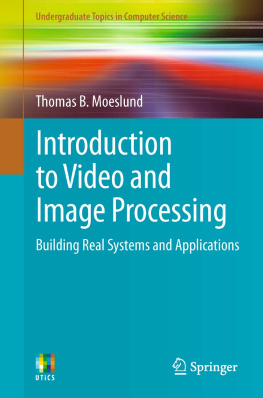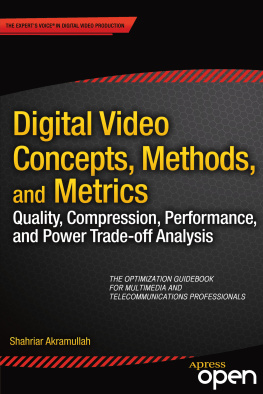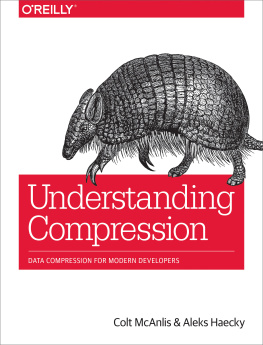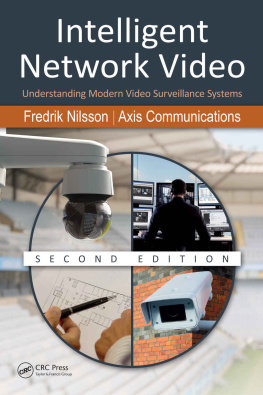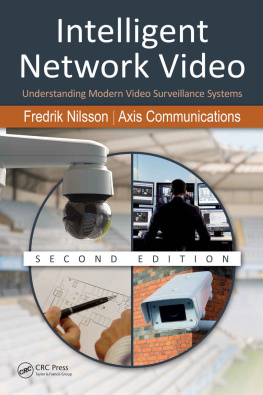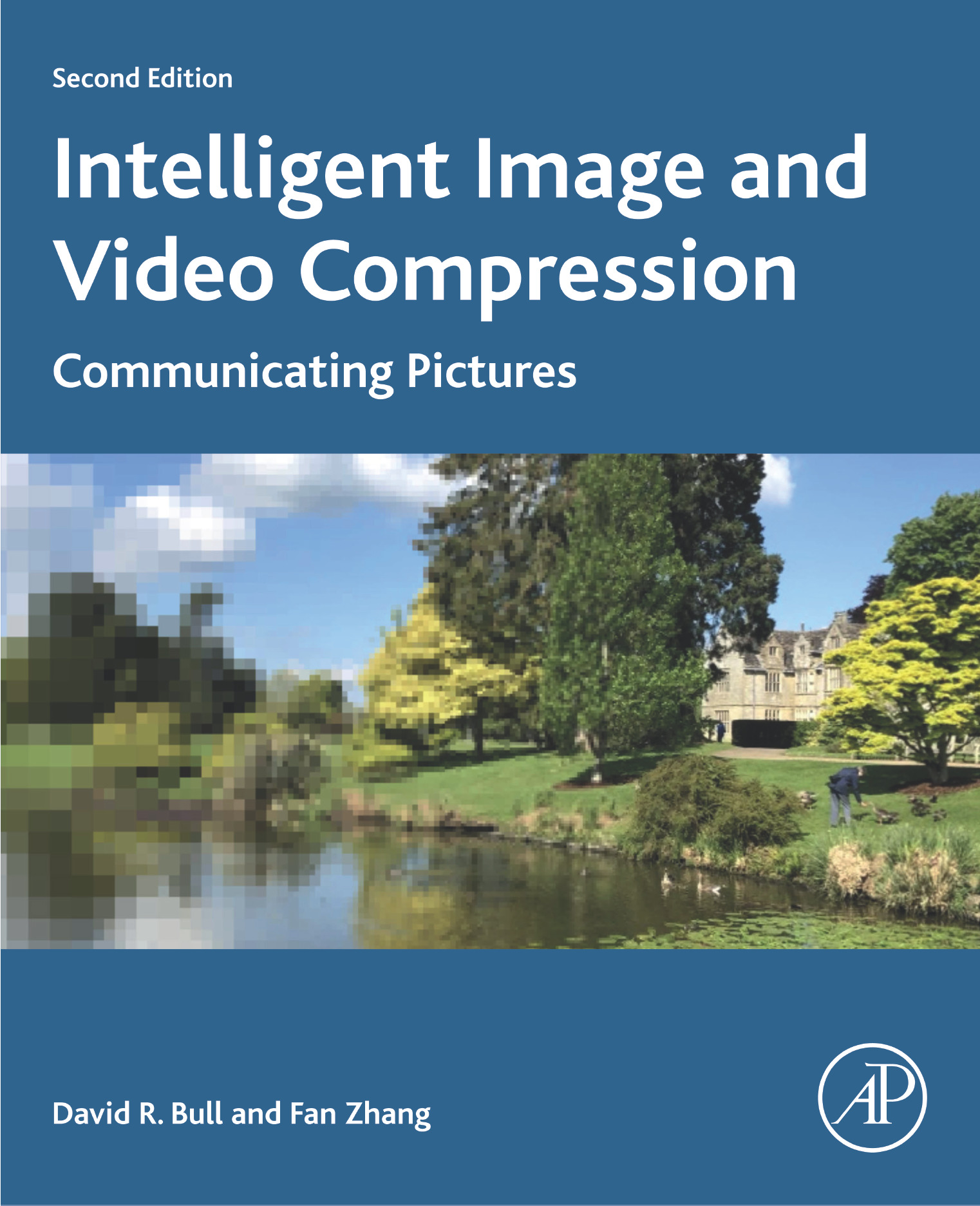Intelligent Image and Video Compression
Communicating Pictures
Second edition
David R. Bull
Fan Zhang

Table of Contents
List of tables
- Tables in Chapter 1
- Tables in Chapter 4
- Tables in Chapter 6
- Tables in Chapter 7
- Tables in Chapter 8
- Tables in Chapter 9
- Tables in Chapter 10
- Tables in Chapter 11
- Tables in Chapter 12
- Tables in Chapter 13
List of figures
- Figures
- Figures in Chapter 1
- Figures in Chapter 2
- Figures in Chapter 3
- Figures in Chapter 4
- Figures in Chapter 5
- Figures in Chapter 6
- Figures in Chapter 7
- Figures in Chapter 8
- Figures in Chapter 9
- Figures in Chapter 10
- Figures in Chapter 11
- Figures in Chapter 12
- Figures in Chapter 13
Landmarks
Copyright
Academic Press is an imprint of Elsevier
125 London Wall, London EC2Y 5AS, United Kingdom
525 B Street, Suite 1650, San Diego, CA 92101, United States
50 Hampshire Street, 5th Floor, Cambridge, MA 02139, United States
The Boulevard, Langford Lane, Kidlington, Oxford OX5 1GB, United Kingdom
Copyright 2021 Elsevier Ltd. All rights reserved.
MATLAB is a trademark of The MathWorks, Inc. and is used with permission.
The MathWorks does not warrant the accuracy of the text or exercises in this book.
This book's use or discussion of MATLAB software or related products does not constitute endorsement or sponsorship by The MathWorks of a particular pedagogical approach or particular use of the MATLAB software.
No part of this publication may be reproduced or transmitted in any form or by any means, electronic or mechanical, including photocopying, recording, or any information storage and retrieval system, without permission in writing from the publisher. Details on how to seek permission, further information about the Publisher's permissions policies and our arrangements with organizations such as the Copyright Clearance Center and the Copyright Licensing Agency, can be found at our website: www.elsevier.com/permissions.
This book and the individual contributions contained in it are protected under copyright by the Publisher (other than as may be noted herein).
Notices
Knowledge and best practice in this field are constantly changing. As new research and experience broaden our understanding, changes in research methods, professional practices, or medical treatment may become necessary.
Practitioners and researchers must always rely on their own experience and knowledge in evaluating and using any information, methods, compounds, or experiments described herein. In using such information or methods they should be mindful of their own safety and the safety of others, including parties for whom they have a professional responsibility.
To the fullest extent of the law, neither the Publisher nor the authors, contributors, or editors, assume any liability for any injury and/or damage to persons or property as a matter of products liability, negligence or otherwise, or from any use or operation of any methods, products, instructions, or ideas contained in the material herein.
Library of Congress Cataloging-in-Publication Data
A catalog record for this book is available from the Library of Congress
British Library Cataloguing-in-Publication Data
A catalogue record for this book is available from the British Library
ISBN: 978-0-12-820353-8
For information on all Academic Press publications visit our website at https://www.elsevier.com/books-and-journals
Publisher: Mara Conner
Acquisitions Editor: Tim Pitts
Editorial Project Manager: Isabella C.Silva
Production Project Manager: Kamesh Ramajogi
Designer: Mark Rogers
Typeset by VTeX 
List of figures
- Figure 0.1 Drawing Ochre: c. 200,000 BCE, South Africa (Courtesy Professor Alice Roberts).
- Figure 1.1 A geometric interpretation of compression.
- Figure 1.2 The multimedia communications jigsaw puzzle.
- Figure 1.3 Simplified video compression architecture.
- Figure 1.4 The scope of standardization.
- Figure 1.5 A chronology of video coding standards from 1988 to the present date (dates in parentheses indicate first published standard and last published revision).
- Figure 1.6 The creative continuum.
- Figure 2.1 The visible spectrum.
- Figure 2.2 Cross-section of the human eye (public domain:
- Figure 2.3 Fundus image of a healthy retina (public domain:
- Figure 2.4 The focal length of the lens.
- Figure 2.5 Photoreceptor distribution in the retina (reproduced with permission from [13]).
- Figure 2.6 Normalized rod and cone responses for the human visual system (adapted from Bowmaker and Dartnall [14]; publicly available
- Figure 2.7 Retinal cell architecture (public domain image adapted from
- Figure 2.8 Spatial opponency, showing a center-surround cell and its firing pattern due to excitation.
- Figure 2.9 The visual cortex and visual pathways.
- Figure 2.10 Mach band effect.
- Figure 2.11 Adelson's grid (reproduced with permission from
- Figure 2.12 CIE luminous efficiency curve (publicly available:
- Figure 2.13 Dark adaptation of rods and cones.
- Figure 2.14 Increased immersion from color images.
- Figure 2.15 Opponent processing of color.
- Figure 2.16 The CIE.1931 chromaticity chart (reproduced with permission from [22]).
- Figure 2.17 Just noticeable differences at different contrast increments.
- Figure 2.18 JND curve for human vision.
- Figure 2.19 Contrast sensitivity chart.
- Figure 2.20 Luminance and chrominance CSF responses.
- Figure 2.21 Luminance contrast sensitivity function.
- Figure 2.22 Texture change blindness (images courtesy of Tom Troscianko).
- Figure 2.23 The importance of phase information in visual perception. Left: Original. Right: Phase-distorted version using the complex wavelet transform (reproduced from [16]).
- Figure 2.24 Perspective-based depth cues can be very compelling and misleading.
- Figure 2.25 Pits and bumps deceptive depth from lighting.
- Figure 2.26 The hollow mask illusion.
- Figure 2.27 Spatio-temporal CSF (adapted from Kelly [18]).
- Figure 2.28 Variation of critical flicker frequency (reproduced from Tyler [24]).
- Figure 2.29 Eye movements in response to a task (from Yarbus [29]; publicly available from
- Figure 2.30 Example of texture masking. (Top left) Three cues are shown on a gray background. (Top right) With zero-mean, 0.001 variance Gaussian noise. (Bottom left) With 0.01 variance noise. (Bottom right) With 0.03 variance noise.
- Figure 2.31 Edge masking for high and low dynamic range content.
- Figure 2.32 Temporal masking effects for various edge step sizes (adapted from Girod [31]).
- Figure 3.1 Spectral characteristics of sampling and aliasing.
- Figure 3.2 Demonstration of aliasing for a 1D signal: Top: Sinusoid sampled below Nyquist frequency. Bottom: Fourier plot showing spectral aliasing.



